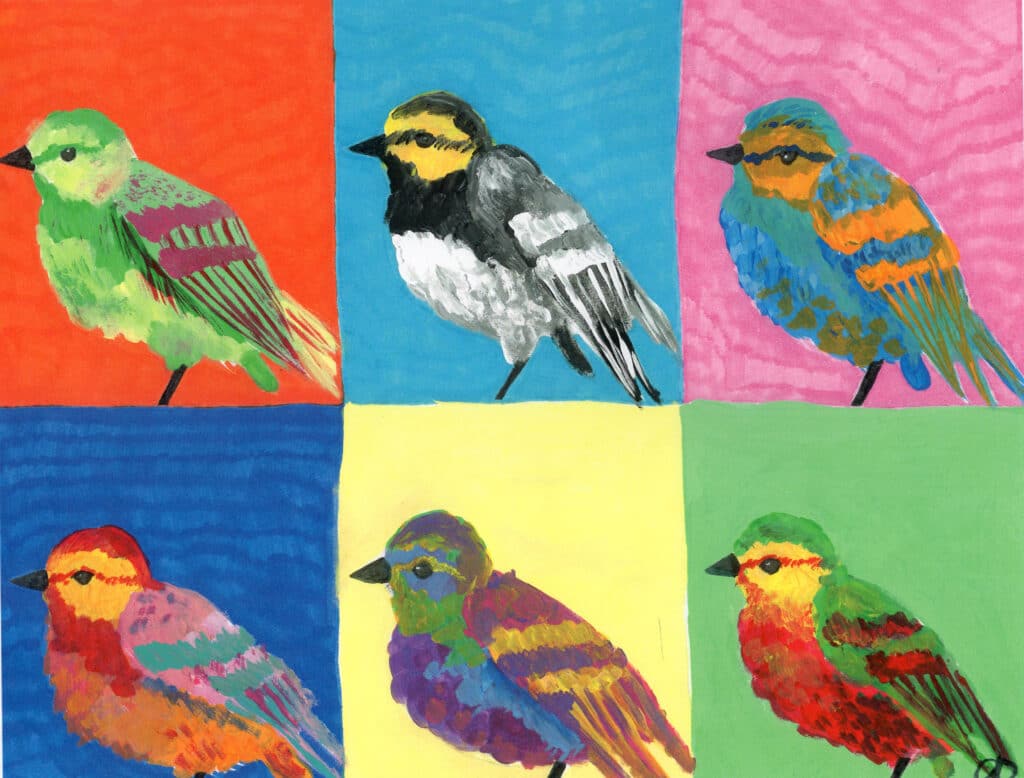How can teachers and parents support artistically gifted children? What is artistic process like for young people?
In this installment of the Interview with a Gifted Kid series, we’ll meet Ava, an 8th-grader from Texas who is an accomplished artist.
This interview is different from the norm in that Ava is artistically gifted. She’s exceptionally bright as well, but this interview focuses on her artistic giftedness.
At the time of the interview, Ava had submitted a piece of work to a contest that will be discussed in the article. As you read the article, I think you will be struck as I was by how similar the issues of intellectual giftedness and artistic giftedness are. It’s a fascinating look into the mind and talent of an incredible young woman.
In the interest of full disclosure, Ava’s father is the illustrator of the cover of my book Living Gifted, and I am very good friends with both her mom and dad. That relationship in no way impacted my awe of Ava. She’s stellar, even if you don’t know her parents.
This is the longest interview I’ve shared, and there are so many gems in here. Teachers and parents can use this as a great discussion starter to explore students’ and childrens’ feelings about their skills, abilities, gifts, and interests.
Other than the drawing she created for the contest, all of the other drawings are from Ava’s sketchbook.
Be sure to read the accompanying interview I did with her father, Dan. It’s an eye-opening view at the role of parents raising a gifted child.
The Interview with a Gifted Kid Series
As part of my mission to make the world safe for the gifted, I interview gifted kids (and grown-up gifted kids) and share their stories of life in Giftedland.
My hope is that it will create a body of voices that will be persuasive that gifted students have needs, that giftedness isn’t some “get out of hardship in school free” card, and that it will give hope to gifted individuals that they are not alone.
If you’d like to be interviewed, please contact me. I want the stories told.
If you’d like to read all of the stories, you can find them here.
Let’s jump into my interview with Ava. I’ve divided the interview into sections, and there’s a bonus interview with her dad, who is himself an accomplished artist.
Beginning the Process
Lisa: Tell me about the contest that you are doing.
Ava: It is a schoolwide contest, and it’s middle school and high school. The name of the contest is Imagine No Violence, and this year’s theme was Imagine Safety for All. They just want an art piece that represents a place that would be safe for all races and ethnicities.
Lisa: Have you done contests before?
Ava: Yes. This year, I’ve done a contest that celebrated Martin Luther King, and I did an art piece for that.
Lisa: When you heard the theme did you have an idea that came to mind right away, or did it take time?
Ava: I think when I first hear the theme for a contest or anything related to art, I can get overwhelmed because there are so many ways I could go about this. How do I pick the right one? So I have a couple ideas later on, but I don’t think of anything instantly.
Lisa: Tell me a little bit about the process when you start working.
Ava: Ideas kind of marinate in my mind, and I’ll write them down or make a primitive sketch so I don’t forget them.
For this contest, I had some ideas, but I just wasn’t hundred percent set on any of them. I got ideas down on paper, but not strong ideas. I thought to myself, “None of these ideas are good enough, none of them really stick out to me. I know I can come up with something better.”
And so it is kind of hard as you look at an idea and then you have that feeling about it like, “This isn’t quite right.”
Lisa: Is that an intellectual feeling to you or is it a gut feeling to you, or a mixture?
Ava: I think it’s a mixture. I just know in my heart and in my brain that it’s not right.
Lisa: And then what’s the feeling that you have when you latch on to the idea that ends up being the one that you stick with? Is it possible to describe that feeling?
Ava: Just satisfaction. I can picture the finished product. I can visualize the finished product. It’s very satisfying.
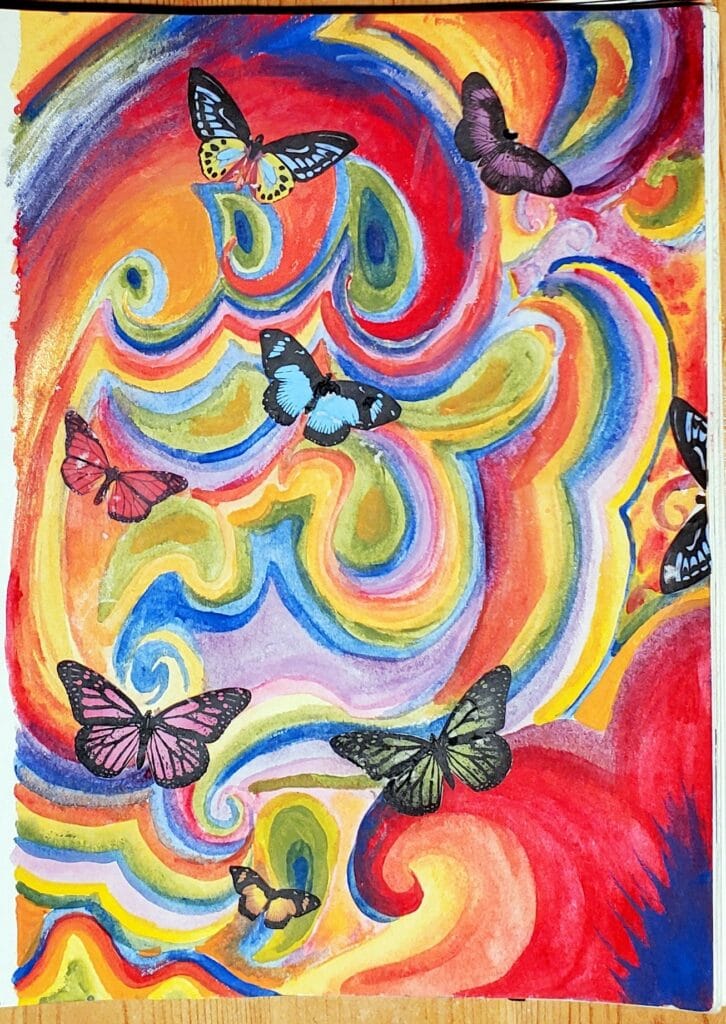
The Struggle of Actualization
Lisa: When you get the idea in your mind, like, “okay, wait, I know I know this is it, this is right.” Do you ever struggle to get it from your mind’s eye onto the medium?
Ava: Of course.
Lisa: Where does that struggle come from? Is it a skill struggle? Is it working with the medium? Is it not being able to get your hand to do what your mind’s eye sees?
Ava: I think kind of what you said. I have these ideas, and I don’t know how I can put them on paper. I just start drawing it, and I have a fuzzy picture. I don’t really know all the details, and so my hand can’t do it. It is very hard, and I definitely just keep playing with it, do some research, do something else.
Lisa: Do you ever have to look up on YouTube for how to do a particular technique?
Ava: Yes. So, I wanted to do a fuzzy background because the lenses in the glasses are clear, and so I wanted to create a blurry background. So I did some research on the internet on how to create a blurry background because in my mind I just saw a fuzzy picture, not exactly how it would look. I didn’t know how to actually execute it, so I had to research it. And that did help a little bit. So yes, there is definitely some research, or asking my dad or something.
The Impact of Expectation
Lisa: So, your dad is a professional artist, and I’m curious about how that is when you are the child of someone with a talent that they are executing professionally. How does that impact you?
Obviously, there are benefits because you can go ask him a question about technique or something. I’m wondering what other pros and cons there are to having a talent or a skill in an area that a parent also has a talent or a skill that is even more developed?
Ava: The obvious one is sometimes people might see my dad’s an art teacher and think my art ability came from his, even though it’s years of practice. And honestly he has taught me almost everything I know, so I couldn’t have done it without him.
But at the same time, just because he’s good at art, that’s not why I like art. I like it because it’s something I like to do. I think we all have very different styles of art, so it never affects me in a negative way.
Lisa: Except for the expectations that some people have or the assumptions they jump to. I think what I’m hearing you say, too, is that you can easily grow up in this house (I’m interviewing you in your home) and still not be an artist. You could not choose that path.
I know your dad’s favorite book is Moby Dick, but that doesn’t mean you love Moby Dick. Do you love Moby Dick?
Ava: Um…I’ve never… [both start laughing]
Lisa: How do you think it has influenced you, not just the fact that your dad is an artist, but being surrounded by his art? I know that your dad has always had the house be very artistic. There are murals on the walls. There are a lot of artistic and architectural techniques and installations essentially in the home. How do you think that has influenced you?
Ava: I think it’s influenced me very positively, because I’m just constantly in this creative, colorful environment, and you know it can inspire you. I can inspire my art to pop and be colorful. It’s very inspirational and comfortable being in a very colorful environment.
Lisa: What’s your favorite piece of art that you have done that gives you that feeling of satisfaction that you described earlier.
Ava: I really don’t know. I mean I really like the one that I just did. Sometimes I like a piece not because of how it turns out, but the message it brought. I liked that one a lot, but there are so many that I don’t think I could really choose.
Lisa: It’s like picking a favorite child, maybe?
Ava: Yeah! Because they’re all different.
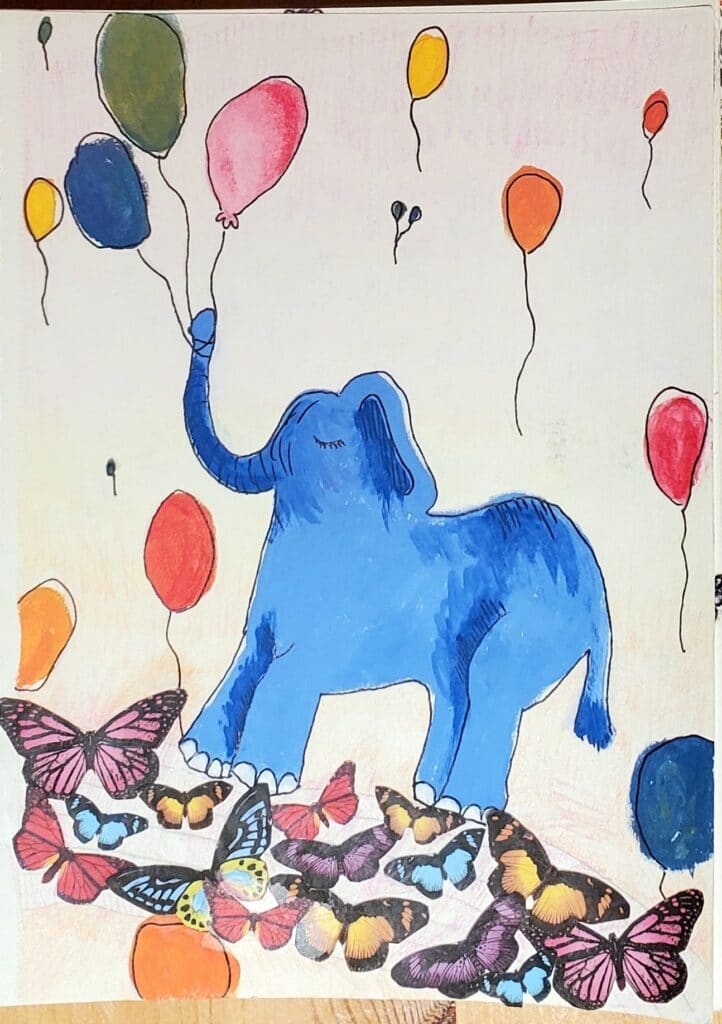
Medium and Tools
Lisa: Do you typically work in the same medium or do you have a preferred medium?
Ava: I really like watercolors and colored pencils. I would say I use colored pencils a lot, and watercolors frequently.
Lisa: What is your favorite brand of colored pencil?
Ava: Well, I like a lot of them. I think Prismacolor are really nice and even Crayola, but some of them are really expensive.
Lisa: Is there a medium that you haven’t worked in that you really want to try, but you haven’t been taught specifically?
Ava: I think it would be cool to learn how to use oil paints or gouache because I think they’re very different from acrylic and watercolor.
Skill, Growth, and Creativity
Lisa: I’d like you to compare two things. First, think of being interested in art and working on art and having a talent for it that you’ve developed. How is that similar or different from someone who has an intellectual ability, like they’re kind of naturally smarter than average and then they work for it.
Or even like sports or dancing. Do you think that all ability is similar in that you can be born with some, but if you don’t do anything with it it won’t really grow, or do you think that art is very different from other forms of talent or skill?
Ava: Oh, I think it is very different, because with everything there is a specific way to do it, but that’s not really true for art.
For example, athletes can kind of change it to what works best and they use their natural abilities to their best, but art is very different because there’s so many different ways to go about it and what looks good to someone else is definitely not going to look good to another audience.
With running, either you make first place or you don’t. With art, everyone has their own style, so I think it is very different.
Lisa: It’s interesting. What I hear you saying is that what makes art different is that there is no defined success. Like in a football game, you either win or you don’t. In art, you can have two people look at the same piece and one of them loves it, and one doesn’t.
What’s interesting to me, though, is then that we’re judging the art based on the eye of the beholder. And so I wonder how that feels to the artists? To me, it seems like an inherent vulnerability — like my work only has value based on how other people see it.
That seems like a real struggle to find value in your work separate from how other people see it. Do you ever struggle with that? Do you ever feel vulnerable when people are looking at your art?
Ava: Sometimes, yes, because everyone has their own taste, but not really. I create art because I like to do it, and it’s therapeutic, not so much because I’m worried about what other people are thinking.
But there are some times where, maybe a classmate sees what I’m working on, you know, everyone has a different story, and they might think it’s absolute crap, but it’s okay.
Education and Encouragement
Lisa: Over the time that you’ve been in school, what has been something that a teacher has done to encourage you in your artistic journey?
Ava: Well, I think the contests are great for providing these opportunities for us to really think – to be given a prompt and really think about how I’m going to make mine different from everybody else’s, how I’m going to make mine stand out, so having those opportunities have really helped me, and I think art teachers are always encouraging you, and they’ll never be hard on you if you make something that might not look very good. They just give you pointers on how to fix things.
I think having a creative environment is always good because art rooms are always colorful. I think that can be inspirational for kids. I didn’t take art last year, just in elementary school and this year.
Lisa: How is the way that art teachers have encouraged you similar or different from the way your other teachers have encouraged you in math, or science, or language arts or social studies?
Ava: I think they’re very different because they encourage you to be different. They want your art to stand out, and they want you to find your own style because you can find yourself through art and find out who you are and that other teachers… I mean, they encourage you, of course, but they encourage you to do things one way. Like, “This is how you solve a math problem.”
Lisa: Yeah, you don’t hear math teachers very often say, “I want you to solve this problem completely differently than anyone has ever solved this problem before!” That’s a good point.
I think maybe I’m biased because I was a language arts teacher, but it seems like language arts teachers do that as well, for example in writing. They want you to have a unique voice. Do you think that’s similar?
Ava: Oh, of course. Yeah, because you can definitely find yourself through your writing, it doesn’t just have to be drawing.
Yeah, I like that because, kind of like art, they give you the basic guidelines on how to draw things, they give you basic guidelines on how to do an essay, and if you follow those guidelines and use correct grammar, you can create a really beautiful piece that will make people stop and read and make you think about something, make them talk about something that should be talked about.
Lisa: Yes, I think it really does. You’re drawing this comparison between writing and visual art as something that is designed to prompt thinking, and to prompt a way of looking at something in a different perspective than it’s been looked at before.
I totally agree with you, and that’s an interesting idea. Within constraint, right? Both fields have constraints. In writing, there are constraints, and certain mediums in writing have more constraint than others. For example, a sonnet is more constrained than an essay or a novel, and in art, abstract impressionism is not as constrained as representational art. That’s interesting.
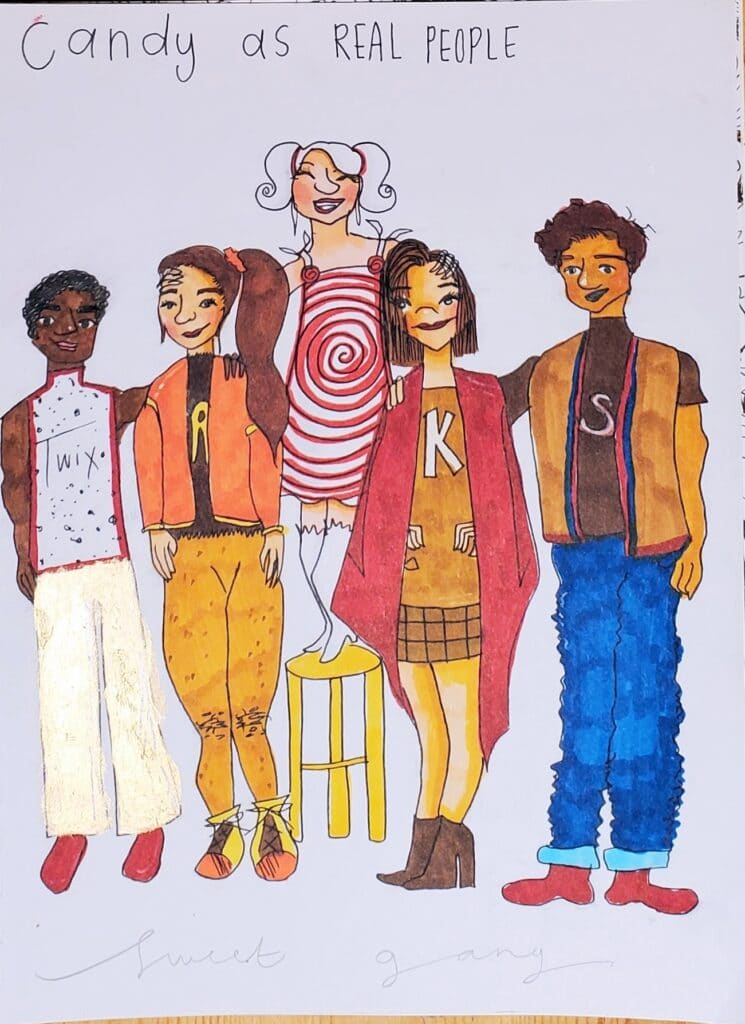
Childhood Appreciation of Art
Lisa: If you could go back to when you were little, and you first started drawing for pleasure beyond what typical kids do… I don’t know what age that was for you, what age do you think you were when you were drawing in a different way from other kids her own age? As far as your interest in it, not necessarily even skill, but just the way that you thought about it.
Ava: Honestly definitely from an early age. When I was old enough to understand, not just drawing stick figures anymore, but I really just developed a hard-core love for it, and it taught me patience, wanting to do these paintings and drawings when I get home from school, so definitely from an early age, probably around seven or eight, maybe even six.
Lisa: And then you were using art, then, as a form of relaxation and enjoyment when other kids, by that age, are kind of moving away from that?
Ava: Right.
Lisa: Let’s go back to eight-year-old Ava, who is sitting in her room at her desk drawing something… What is something that you would like to give as a message to eight-year-old Ava about your art?
Ava: I wish that I had expanded more on what I drew, because it wasn’t normally just princesses or ballerinas, so I wish maybe if I could have expanded my horizons more on drawing different things, but I have no regrets at all. Just kind of letting her know to keep at it, and the love for art was only going to grow.
Lisa: So try to imagine that you’re thirty years old. What is something that you can imagine that thirty-year-old Ava might wish that you knew right now, as eighth grade Ava.
Ava: Hopefully, 30-year-old Ava will be an art therapist by then. Probably just do art for pleasure. I would say don’t focus on how good I actually am, but do it because I love it, not because I’m trying to get better. I mean it’s always good to get better, but just do it because you love it.
Artistic Frustrations and Aspirations
Lisa: What frustrates you?
Ava: When I have an idea, and it’s just it’s too fuzzy, to the point where I can’t even start. I’m just at a blank space, but I want to do it, it’s just too fuzzy, and I can get overwhelmed and I don’t start. Or I get really frustrated when I add too much to a piece, or I just keep going and trying to make it look better but it looks worse and worse. It’s hard to know when to stop.
Lisa: Yeah, I’m nodding because that happens in writing too. A lot of times you make it worse trying to make it better. So, where do you get most of your ideas? And I don’t mean “Oh, I saw a horse and that made me want to draw a horse.” I mean, are you usually in a quiet spot, or are you usually listening to music, or in the shower? Where are you when ideas come for things you want to draw, and what you do with those ideas?
Ava: I mean, sometimes it is kind of a quiet place. Sometimes it’s even on the Internet, maybe I’m watching a video of something totally unrelated and I get this crazy idea, or even just seeing nature, like “it would be pretty to paint a bird,” or something. But yeah, I would say probably quiet space.
Lisa: I don’t know how often this happens to you, but does it frustrate you if people ever say things to you along the lines of how lucky you are, that you’re good at art? And do you ever feel like “this isn’t just luck, I work at this!”
Ava: Yeah I think I get a lot of “Why are you so good at art?” I think they do think it’s luck of the draw, but if I think back, I carried a sketchbook everywhere. In family pictures I always have a little sketchbook in my hand, and it took years and years of practice. But it’s not really frustrating because I’m pretty used to it.
Exposure and Message
Lisa: Do you have a desire besides the contest to share your work more broadly? In the ideal world, would you like to have a website, or an installation, or something like that where people could see it?
Ava: Absolutely, because I want to show people that we can make the world a better place all together. It’s not going to take one race, it’s not going to be only white people or black people, it’s going to take all of us, and that’s why there were two different colored hands holding the glasses, because we’re not going to do this by ourselves.
I think it’d be great to be able to share that with more people and change their mind, instead of thinking hard-heartedly against a race or anything, but softening it, and thinking, “Oh, we can do this together.”
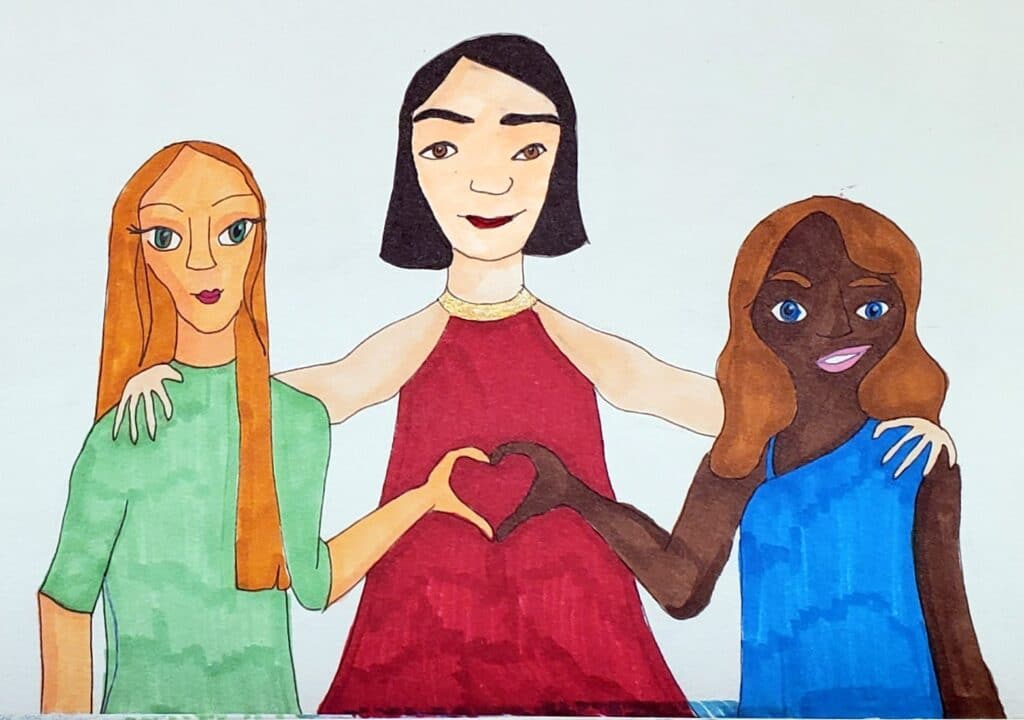
Lisa: So it sounds like it’s almost a motivation. That I would look at art and I would be motivated to action, propelled to action, even if the action is a change of heart, or a willingness to see something differently.
Ava: Yes.
Lisa: So you mentioned that you had a desire to be an art therapist. So it sounds like you have a belief that art has a healing power?
Ava: Yes, I think it would be great because I would get to do art with other people, but also I would get to help people and help them express themselves and find their voice through something like that and be able to heal their mental scars with pen and paper.
Lisa: If there’s somebody, especially a young person like yourself, who feels like they like to do art, in a sense of they like to draw, or they like to paint, or sketch or something, but every time they do they get frustrated because there never as good as they wish they were, what would you say to them?
Ava: I would say just keep going. And not through the years, I mean get a piece of paper and keep drawing.
Don’t think about all the mistakes that you’re making. Think about how it’s making you feel. And not frustration, I mean just don’t worry about those mistakes, just keep moving, and as you add more, the picture will look better, and just practice with it, play with it, play around with it, make things bigger, smaller, until it looks right, or right to them. Just don’t stop at the frustrations.
Lisa: Don’t stop at the frustrations. I like that. (We both laugh.)
Other Interests and Artistic Outlets
Lisa: Besides art, what are some of the other things that you like to do to relax, or that you find enjoyable?
Ava: I really like to knit and I kind of got into macrame, and sometimes I like to sew. If I feel sad or stressed out, I like to exercise.
Lisa: Do you have any favorite books? It doesn’t have to be the one book to rule them all, but do you have any books that you particularly like?
Ava: I really like The Hunger Games, and I’m reading a series right now called Uglies. I got through the first couple books, but I wanted to start over because it’s been a while. Really any kind of dystopian book, I think they’re really cool.
Lisa: Yeah, you know, dystopian fiction has become so popular and that didn’t used to be the case. When I was in school, the dystopian novels were all political. Like Animal Farm, 1984, you know, George Orwell-type stuff, and now they’ve blended this element of fantasy as opposed to political commentary, and it’s interesting to me because it seems like so many young readers like it, and at the same time to me as an adult reader looking at it, it feels like a short ride from there to a depressive state, like they’re not uplifting really. Yet a lot of young readers really like them. Is it possible for you to explain what you like about it? Is there anything in particular that you like?
Ava: Of course it depends on what book you read, because they all describe their dystopian world differently, but just the whole world, I think it’s just so cool. I don’t think I’d ever want to live there, a lot of them are kind of depressing (laughter), but I love the environment, the atmosphere, the idea of thinking, “Oh, you know, the government controls everything, they control people’s minds,” or just thinking of something that is somewhat realistic, but futuristic. I love the dystopian world, and getting to be in it for a little bit, I think it’s cool.
Lisa: Okay, interestingly, when you’re talking about the world building, and that’s the term we use in literature, that to me aligns with your art, because it is as though the author is painting a picture of the way the world could possibly be. It lets you do what art that you do, which is to see something that looks similar to what you’re used to seeing, but yet there’s a twist on it, and then it makes you think differently, approach things differently. It makes sense to me when you were talking, I thought there’s a connection between art and the dystopic world building.
Did you like the Harry Potter books? Because they have strong world building.
Ava: I’ve never read them, actually. I tried to start but I was a little bit too young, so I never got through the first couple pages I don’t think.
Lisa: Okay, well, you’re going to need to fix that! (laughter)
Representation in Art
Lisa: In dystopian fiction, the female characters are often very strong. Is that something else that you like?
Ava: Oh yeah, I love female empowerment, and I love that the females so often tend to take the lead, and they think in a way differently than everyone, else, like, they’re different because their head isn’t a bubble, and they find out what the government is doing, or… I love that they’re different. They can find out what the problem is, and they do something about it.
Lisa: Suzanne Collins, who wrote The Hunger Games, said that she based the character of Catniss on Theseus, from mythology, a hero, and and if you read the Hunger Games book, especially just the first volume, Catniss does follow that heroic archetype that we’re used to.
An unusual circumstance of birth, her dad is dead, you know, that’s very, very common for heroes that something’s gone wrong with the parents (laughter). Think about Luke Skywalker, right? Why are you living on this planet with your aunt and uncle? And then there’s this inciting incident that sets her on her journey, which in this case, she puts herself in her sister’s place, and then there are the series of tests, and in the end she saves everything. You have to have a weapon, which of course she has her arrow, right, but she also has her intelligence, and I think that’s what it sounds like resonated with you.
It’s that she’s using her intelligence and her wits, and not her appearance, even though her appearance does play an important role. So it seems like Hunger Games is sending the message that you can care about how you look, but not use it to move yourself forward. You use your mind and your skill to move yourself forward, but you use your looks to empower or reflect how you feel about yourself inside.
Ava: Yeah, absolutely.
Intended Take-aways
Lisa: So people are going to see this picture you created for the contest. Over the lifetime of the article fifty, sixty thousand people will see the article, will see this piece of art that you’ve done, and I’m curious what you would hope people will think.
You said earlier that you want them to take away the idea that we can work together to make a better world. When they see the art, what is in this piece that you feel sends that message, besides the hands that are multiple colors. What are some of the other motifs in the piece that you hope people recognize?
Ava: Well there are some little things. I put cracks in the background, to show violence and hatred and things of that nature, they’re not stable, they’re not a stable place that you can stand on.
Eventually they’re always going to fall down, and righteousness will empower everything. It’s all going to crash down, it never ends well.
The prompt for this contest, they were talking about how when people feel safe, you can heal, you can learn things and expand your talents, and your knowledge, and you can feel comfortable in your own skin, and that we can accept other people regardless of their disabilities. Like there’s some people in wheelchairs in there.
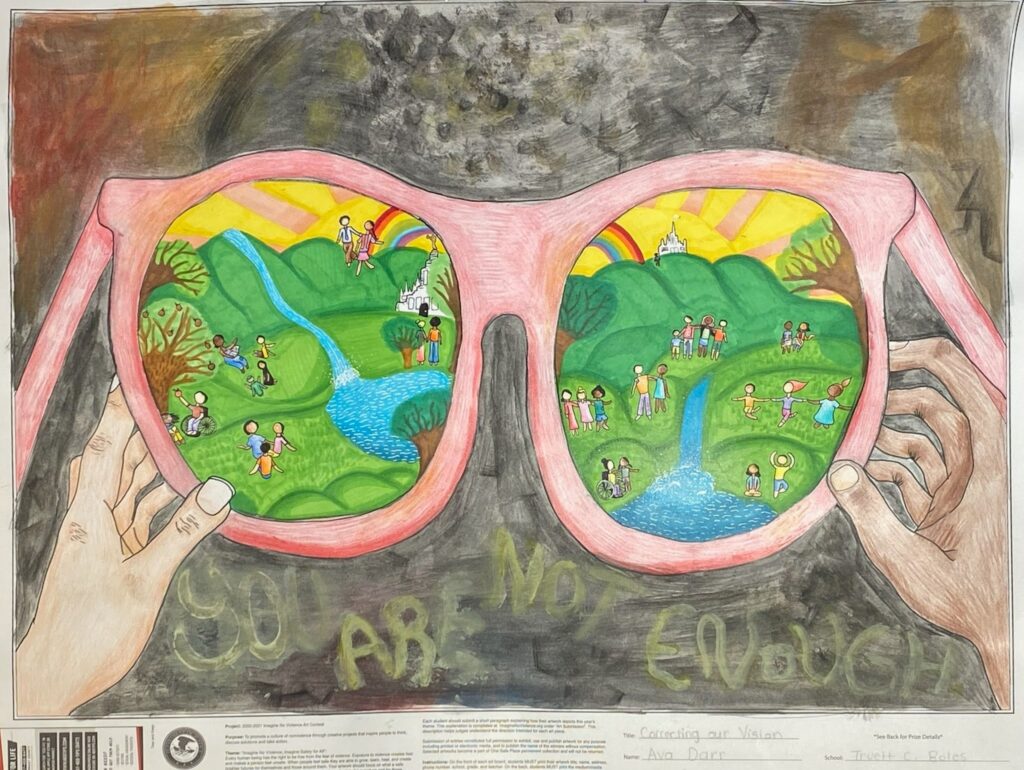
Lisa: People in wheelchairs in your drawing?
Ava: Yes, we can accept them and accept people, you know, different colors and different faiths, and that darkness is not a foundation that we can trust in.
Lisa: So there in the image, in the lenses of the glasses, there’s a lot going on. What is something that you think people might miss? Are there any little things in there that you think it’s possible that somebody can look at it and not notice, that you feel are worth seeing?
Ava: I think there’s some little things. I put an adult woman in a wheelchair next to the water, and put a little child next to her, standing, and she’s kind of putting her arm out, showing the adult the water. I thought that was cool, because I wanted to show we can learn a lot from children, the child is helping the adult, to show even grown-ups and adults can be very vulnerable, and it’s okay to learn lessons from children because they have so many wonderful things to say. I could also put some temples in there to express my beliefs, put some of me in there, to show we can be safe with the Lord.
Also, at first I wanted the man to be doing yoga or something, to show that not only girls do yoga, but I like the pirouette better. I did try to show more gender equality and different perspectives, and I like that you brought up that all the people are touching because I didn’t even notice that. They could definitely all be engaged with one another. Our world really could be like this, if we really worked hard, it could come to life. I think that was pretty much it. The rest is pretty self-explanatory.
Bread & Butter Techniques; Branching Out
Lisa: I know that it probably varies from day to day or project to project, but do you have a color that you routinely go to? Not a favorite, but your Swiss Army Knife color?
Ava: I really like blue, I definitely go blue a lot.
Lisa: What kind of blue? A royal blue, a more periwinkle blue, teal, aquamarine, turquoise?
Ava: More like light baby blue, that area.
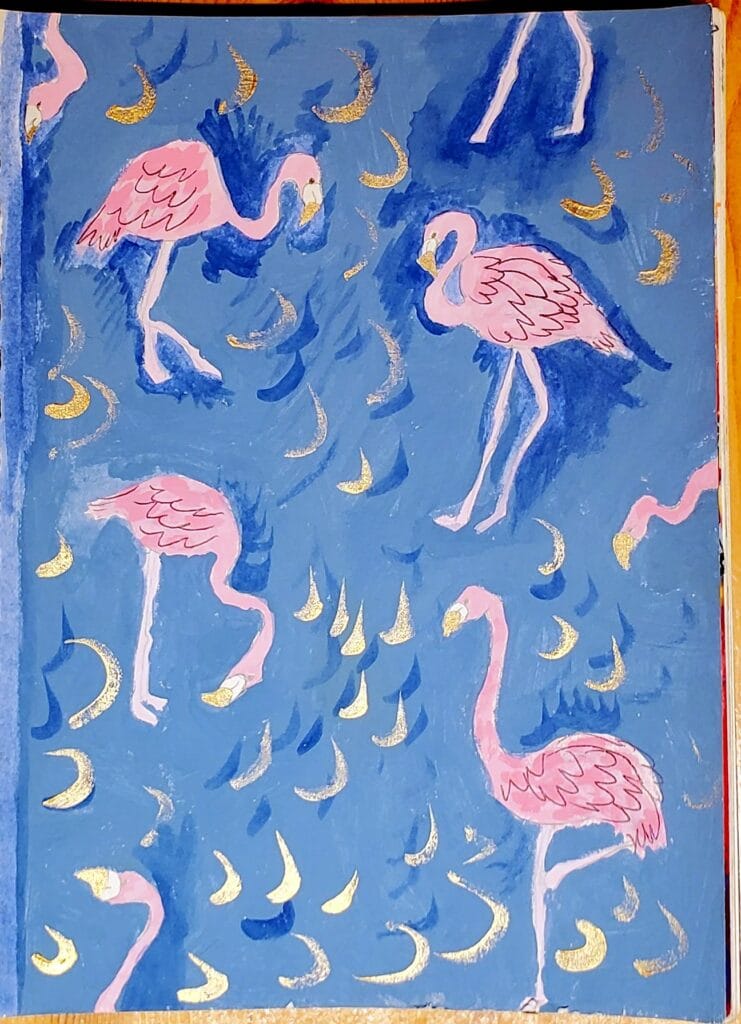
Lisa: Do you have a least favorite color?
Ava: Honestly, no, because I think all the colors work together, and I mean you can paint a beautiful painting of even a swamp, and all those browns or vomit-greens, they all work together to create a beautiful painting, so they’re all needed. I think they’re all very essential and beautiful in their own way.
Lisa: Do you see a similarity between the colors, the way that you just described them, and people?
Ava: Yes, I think sometimes we can look at a person, judge them just based on what they look like or how they act, but really each one of us are essential to a plan.
We are all needed. Every color is needed to create a painting or a picture, and they all have their own way that they can be an instrument in God’s hands, because they have been given special gifts. Like you can use a weird color in a way that would suit it best, and it would look beautiful. So I think it does definitely relate to people.
Lisa: Is there anything that you don’t know how to do in art that you wish you knew right now? I know we talked earlier about mediums and you said like gouache and oils, but besides that, a technique?
Ava: Yes, I really want to be able to learn to do a self-portrait. I can do self-portrait but I want to be able to add in blues or pinks in the face, for shadows, to show contrast, and I don’t know how to do that because Imight put the colors in the wrong place or something like that.
So I want to learn to be able to use bright colors for shading on something that normally isn’t colorful. And also if you think about Starry Night, there are different tiny lines of different colors, I would love to know how to be able to do that. Not create a solid color, but use different yellows or reds on one thing and unify it.
Lisa: Do you have a favorite painting?
Ava: The classics I really like. Girl with a Pearl Earring or obviously I like Starry Night, but I feel like I don’t look at paintings that much.

Lisa: That’s interesting, it’s like a writer who doesn’t read that much. It happens! People expect that all writers are readers, and that’s not true.
I have listened to a podcast with an author who writes cozy mysteries, which is a genre and he doesn’t even read cozy mysteries. I don’t think he’s read a single one, but he writes them, and I think that a lot of times people assume that if you’re an artist you just want to live at museums, yet it’s a very different experience to take in art versus produce art, and some people like both and some people like one or the other.
Like you and I live in between a couple of amazing museums, and I go there and I don’t feel any desire to try to re-create this thing, but I can still appreciate it. On the other hand, you may go there and feel like, “I want to learn how to do what they did in that,” so it’s more inspiring on a different level as well.
Ava: Yes it’s definitely what you said, or maybe I do see something that I really like, I just don’t know the title of it, or it might not be well-known, but I definitely agree with what you said.
Lisa: Well Ava, I want to thank you so much for your time. I really appreciate it.
Ava: Thank you so much for this opportunity!
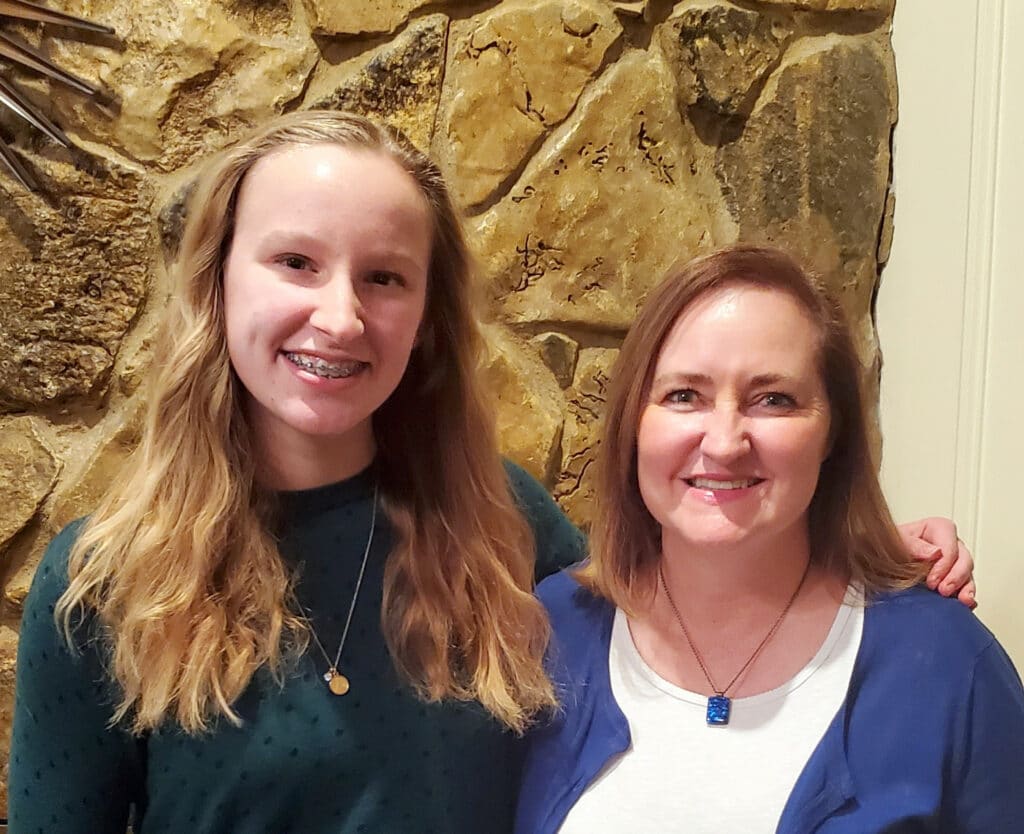
Take-aways:
Even though I was there, I still find myself thinking of some of the ideas that came out of this discussion.
- The role of contest and challenge is underutilized. Too many people try to protect children from nervousness or disappointment.
- Ava’s attitude towards frustration is an example to us all. Her understanding of the need to keep trying and keep learning as part of the process was wise beyond her years.
- Just as with cognitive giftedness, Ava experiences the belief people have that it just comes easy to her. It’s so interesting that that’s an issue in so many domains. It seems that people would prefer to believe that you either have it or you don’t so they don’t feel they have to work hard. Carol Dweck would really like Ava.
- I loved the way she describes the world she hopes we have one day and the way she expresses that dream through her art.
- There were a number of times where her attitudes went against common belief (for example, when she expressed that she doesn’t haunt museums and immerse herself in art all of the time). These are instructional.
- The connections between the challenges Ava faces in her artistic talent so closely mirror the challenges we see in scholastic endeavors as well. It was shocking to me how universal the gifted experience is.
Afterword:
Ava’s picture discussed above was a winner in early rounds of the contest. Recently, she sent me this gorgeous drawing of birds she submitted to an art contest that she won.
